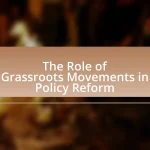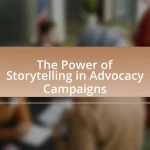The main entity of the article is the power of storytelling in advocacy campaigns. The article explores how storytelling creates emotional connections, enhances engagement, and drives action in advocacy efforts. It highlights the effectiveness of personal narratives, data-driven stories, and collective experiences in making complex issues relatable and memorable. Key elements of effective storytelling, such as emotional appeal and relatable characters, are discussed, along with strategies for organizations to implement storytelling in their campaigns. Additionally, the article addresses challenges, best practices, and methods for measuring the impact of storytelling on advocacy outcomes.
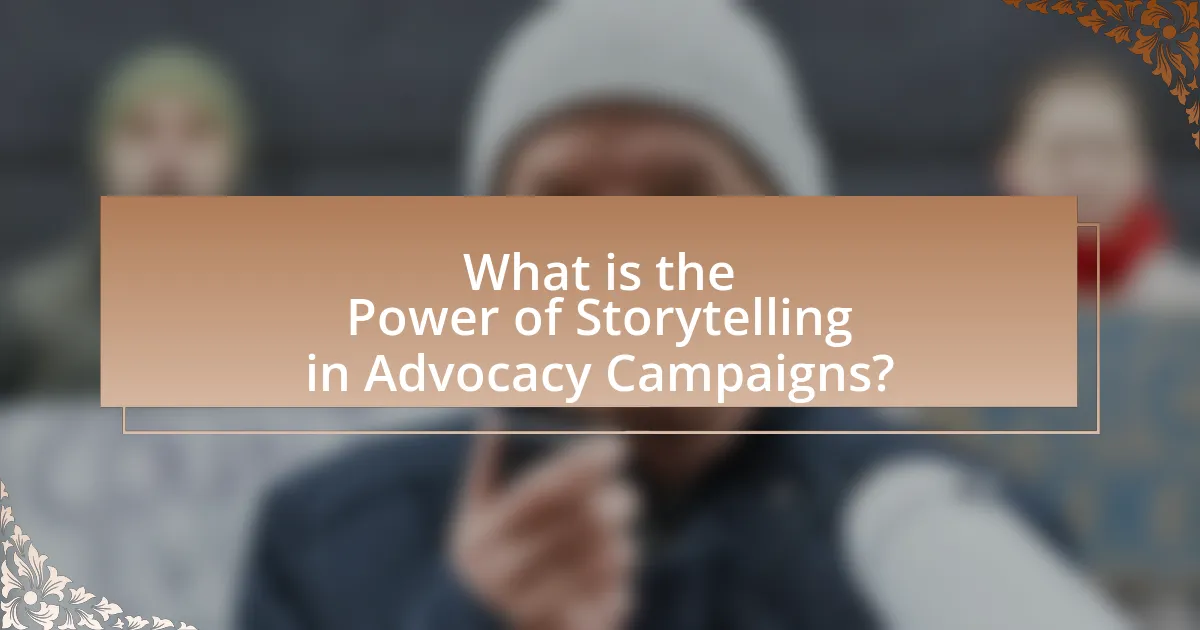
What is the Power of Storytelling in Advocacy Campaigns?
The power of storytelling in advocacy campaigns lies in its ability to create emotional connections and drive engagement. Storytelling humanizes complex issues, making them relatable and memorable for the audience. Research indicates that narratives can increase information retention by up to 65%, as people are more likely to remember stories than statistics alone. Furthermore, effective storytelling can inspire action; for instance, campaigns that utilize personal stories often see higher rates of donations and volunteer sign-ups. This effectiveness is rooted in the psychological impact of stories, which can evoke empathy and motivate individuals to support a cause.
How does storytelling influence advocacy efforts?
Storytelling significantly influences advocacy efforts by creating emotional connections that engage audiences and motivate action. When advocates share personal narratives or compelling stories, they humanize complex issues, making them relatable and easier to understand. Research indicates that stories can increase empathy and retention of information; for example, a study published in the journal “Psychological Science” found that narratives can enhance persuasion by up to 50% compared to statistical data alone. This emotional resonance drives individuals to support causes, participate in campaigns, and mobilize others, ultimately amplifying the impact of advocacy initiatives.
What are the key elements of effective storytelling in advocacy?
The key elements of effective storytelling in advocacy include a clear message, emotional connection, relatable characters, and a compelling narrative structure. A clear message ensures that the audience understands the core issue being addressed, while an emotional connection engages them on a personal level, making the story resonate. Relatable characters, often representing the affected individuals or communities, help the audience empathize with the situation. A compelling narrative structure, which typically includes a beginning, middle, and end, guides the audience through the story, creating a sense of urgency and prompting action. These elements are supported by research indicating that stories with emotional appeal are more persuasive and memorable, as demonstrated in studies by the Stanford Graduate School of Business, which found that emotional storytelling can significantly influence decision-making and advocacy outcomes.
How does emotional engagement enhance storytelling in campaigns?
Emotional engagement enhances storytelling in campaigns by creating a deeper connection between the audience and the message. This connection fosters empathy, making the audience more likely to relate to the narrative and take action. Research indicates that emotionally charged stories can increase information retention by up to 65%, as emotions trigger the brain’s reward system, reinforcing memory and engagement. For example, campaigns that utilize personal stories of individuals affected by an issue often see higher levels of support and participation, as these narratives resonate on a human level, driving both awareness and advocacy.
Why is storytelling important for advocacy campaigns?
Storytelling is important for advocacy campaigns because it effectively engages audiences and fosters emotional connections. By presenting relatable narratives, advocacy campaigns can illustrate complex issues in a way that resonates with individuals, making the message more memorable and impactful. Research indicates that stories can increase information retention by up to 22 times compared to facts alone, highlighting their power in influencing public perception and motivating action. Furthermore, storytelling can humanize abstract concepts, allowing audiences to empathize with the subjects of the advocacy, thereby driving support and mobilizing communities for change.
What role does storytelling play in shaping public perception?
Storytelling plays a crucial role in shaping public perception by creating emotional connections and facilitating understanding of complex issues. Through narratives, individuals can relate to experiences and perspectives that may differ from their own, fostering empathy and engagement. Research indicates that stories are more memorable than facts alone; for instance, a study published in the journal “Psychological Science” found that narratives can enhance information retention by up to 22 times compared to non-narrative formats. This ability to resonate emotionally and enhance memory makes storytelling a powerful tool in advocacy campaigns, influencing opinions and driving social change.
How can storytelling drive action and mobilize supporters?
Storytelling can drive action and mobilize supporters by creating emotional connections that inspire individuals to engage with a cause. When narratives are crafted effectively, they resonate with audiences on a personal level, making complex issues relatable and motivating them to take action. For instance, studies show that stories can increase empathy and understanding, leading to higher levels of support; a report by the Stanford Social Innovation Review highlights that storytelling can enhance the perceived urgency of social issues, prompting individuals to contribute time, resources, or advocacy efforts. This emotional engagement transforms passive observers into active participants, ultimately amplifying the impact of advocacy campaigns.
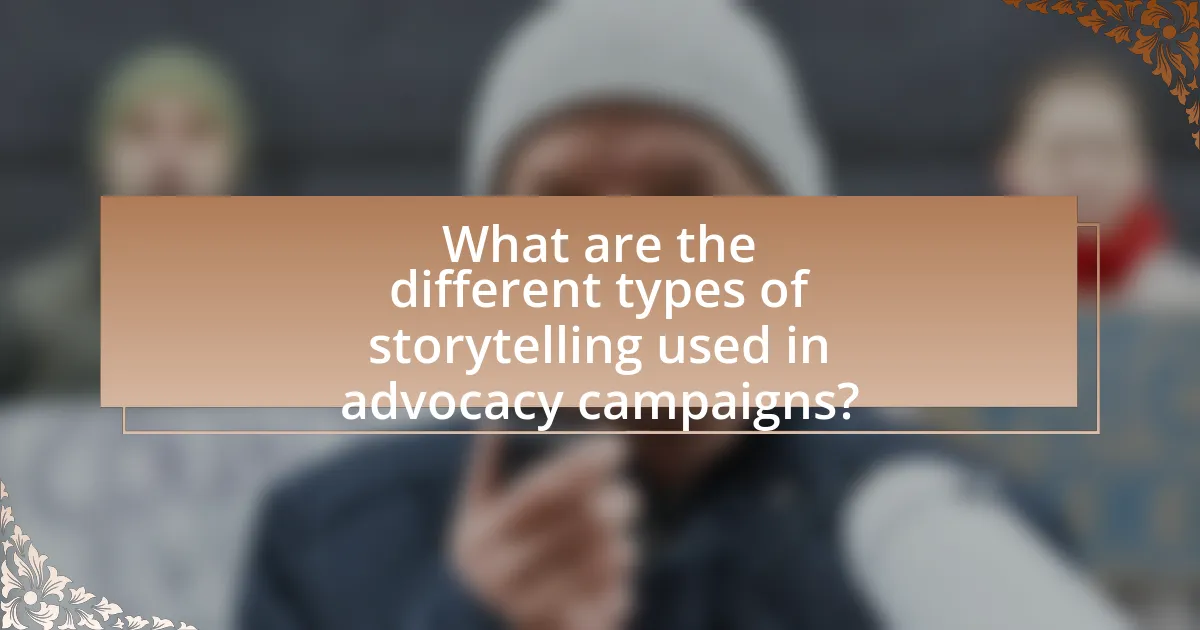
What are the different types of storytelling used in advocacy campaigns?
Advocacy campaigns utilize several types of storytelling, including personal narratives, data-driven stories, and collective stories. Personal narratives focus on individual experiences to evoke empathy and connect emotionally with the audience, often highlighting personal struggles or triumphs related to the advocacy issue. Data-driven stories incorporate statistics and research findings to provide a factual basis for the campaign, making the argument more compelling and credible. Collective stories emphasize shared experiences or community challenges, fostering a sense of unity and collective action among the audience. These storytelling types are effective in engaging audiences and driving action, as evidenced by campaigns like the “It Gets Better Project,” which used personal narratives to support LGBTQ+ youth, demonstrating the impact of storytelling in advocacy.
How do personal narratives impact advocacy effectiveness?
Personal narratives significantly enhance advocacy effectiveness by fostering emotional connections and increasing relatability. When advocates share personal stories, they humanize issues, making them more accessible and compelling to the audience. Research indicates that narratives can evoke empathy, which is crucial for motivating action; for instance, a study published in the journal “Health Communication” found that personal stories increased the likelihood of individuals supporting health-related initiatives by 50%. This emotional engagement leads to greater awareness and mobilization around advocacy causes, demonstrating that storytelling is a powerful tool in influencing public perception and driving change.
What makes personal stories resonate with audiences?
Personal stories resonate with audiences because they evoke empathy and create emotional connections. When individuals share their experiences, they often highlight universal themes such as struggle, triumph, and vulnerability, which allow listeners to relate on a personal level. Research indicates that narratives activate the brain’s mirror neurons, fostering a sense of shared experience and understanding. For instance, a study published in the journal “Cognitive Science” by Paul Zak found that storytelling can increase oxytocin levels, a hormone associated with empathy, thereby enhancing audience engagement and response. This emotional engagement is crucial in advocacy campaigns, as it motivates action and fosters a sense of community among supporters.
How can organizations collect and share personal narratives?
Organizations can collect and share personal narratives through structured interviews, surveys, and digital storytelling platforms. By conducting interviews, organizations can gather in-depth stories directly from individuals, ensuring authenticity and emotional resonance. Surveys can be utilized to reach a broader audience, allowing individuals to share their experiences in a more accessible format. Digital storytelling platforms, such as social media or dedicated websites, enable organizations to disseminate these narratives widely, fostering community engagement and advocacy. Research indicates that storytelling can significantly enhance the impact of advocacy campaigns by creating emotional connections and increasing awareness, as evidenced by studies showing that narratives can improve message retention and influence public opinion.
What role does data storytelling play in advocacy?
Data storytelling plays a crucial role in advocacy by transforming complex data into compelling narratives that resonate with audiences. This approach enhances understanding and engagement, making it easier for advocates to communicate their messages effectively. For instance, studies show that narratives combined with data can increase retention of information by up to 65%, as they create emotional connections that purely statistical presentations often lack. By leveraging data storytelling, advocates can not only inform but also inspire action, thereby driving social change and influencing policy decisions.
How can data be effectively integrated into storytelling?
Data can be effectively integrated into storytelling by using it to support narratives that resonate emotionally with the audience. This approach involves presenting data in a way that highlights human experiences, making complex information relatable and engaging. For instance, a study by the Data Visualization Society found that stories incorporating data can increase audience retention by up to 70%. By weaving statistics and facts into a compelling narrative, advocates can enhance credibility and drive home their message, ultimately leading to more impactful advocacy campaigns.
What are the benefits of combining data with personal stories?
Combining data with personal stories enhances the effectiveness of advocacy campaigns by making complex information relatable and emotionally engaging. This approach allows audiences to connect with the data on a human level, increasing retention and understanding. Research indicates that narratives can improve information recall by up to 65%, as they provide context that numbers alone cannot convey. Furthermore, personal stories can illustrate the real-world impact of data, fostering empathy and motivating action among stakeholders. This combination ultimately leads to more persuasive communication and stronger advocacy outcomes.
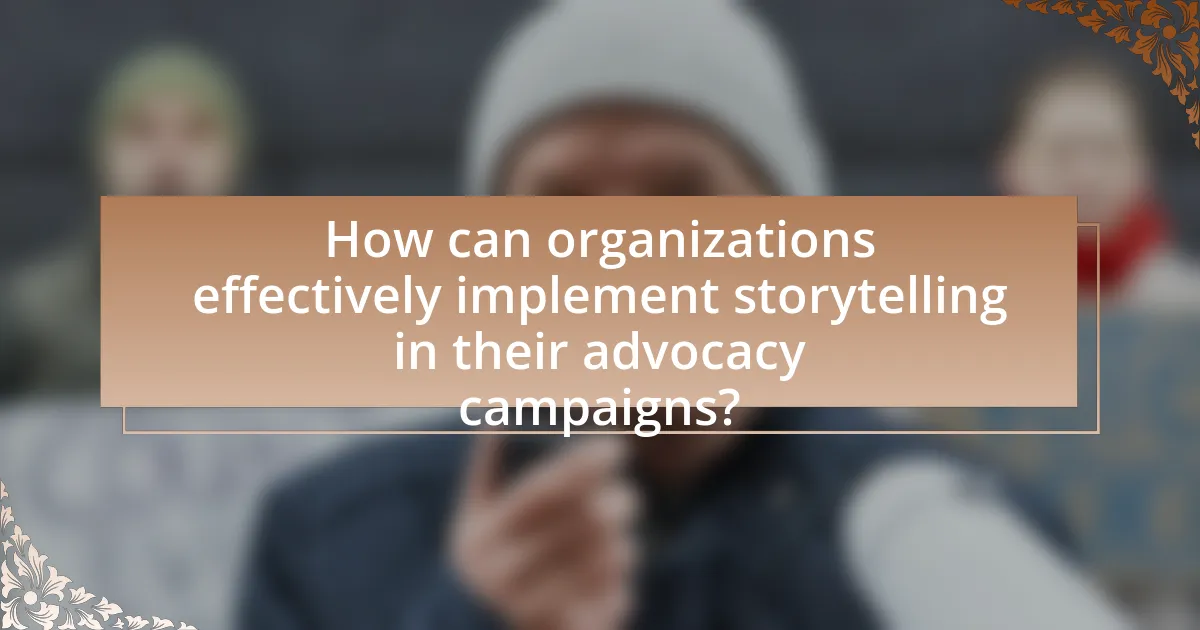
How can organizations effectively implement storytelling in their advocacy campaigns?
Organizations can effectively implement storytelling in their advocacy campaigns by crafting narratives that resonate emotionally with their target audience. This involves identifying relatable characters, presenting a clear conflict, and showcasing a resolution that aligns with the campaign’s goals. Research indicates that emotionally charged stories can increase engagement and retention of information; for instance, a study published in the journal “Psychological Science” found that stories can enhance memory recall by up to 22 times compared to facts alone. By utilizing personal testimonials and real-life examples, organizations can create a compelling narrative that not only informs but also inspires action, thereby increasing the likelihood of achieving their advocacy objectives.
What strategies can enhance storytelling in advocacy efforts?
To enhance storytelling in advocacy efforts, utilizing personal narratives and emotional connections is crucial. Personal stories resonate with audiences, making complex issues relatable and fostering empathy. Research indicates that narratives can increase engagement and retention of information; for instance, a study by the University of Pennsylvania found that stories can improve message recall by up to 22 times compared to statistics alone. Additionally, incorporating visual elements, such as images and videos, can further amplify the impact of the story, as visuals can evoke emotions and enhance understanding. By combining personal narratives with compelling visuals, advocacy campaigns can effectively communicate their messages and inspire action.
How can organizations identify their target audience for storytelling?
Organizations can identify their target audience for storytelling by conducting thorough market research and audience segmentation. This process involves analyzing demographic data, psychographics, and behavioral patterns to understand who their audience is and what resonates with them. For instance, a study by Nielsen found that 92% of consumers trust recommendations from individuals over brands, highlighting the importance of aligning storytelling with audience values and preferences. By utilizing surveys, focus groups, and social media analytics, organizations can gather insights that inform their storytelling strategies, ensuring that the narratives they create are relevant and impactful for their specific audience.
What platforms are most effective for sharing advocacy stories?
Social media platforms, particularly Facebook, Twitter, and Instagram, are the most effective for sharing advocacy stories. These platforms enable rapid dissemination of narratives to large audiences, fostering engagement through likes, shares, and comments. For instance, a study by the Pew Research Center found that 69% of adults in the U.S. use Facebook, making it a prime venue for advocacy groups to reach diverse demographics. Additionally, Twitter’s character limit encourages concise storytelling, while Instagram’s visual focus allows for impactful imagery that can enhance emotional connections to advocacy issues.
What are common challenges in using storytelling for advocacy?
Common challenges in using storytelling for advocacy include ensuring authenticity, engaging diverse audiences, and measuring impact. Authenticity is crucial because audiences can quickly detect insincerity, which undermines the message. Engaging diverse audiences presents a challenge as different groups may have varying cultural contexts and values that affect how stories are received. Additionally, measuring the impact of storytelling on advocacy efforts is difficult, as quantifying emotional responses and behavioral changes can be complex and subjective. These challenges highlight the need for careful consideration and strategic planning in advocacy storytelling.
How can organizations overcome skepticism towards storytelling?
Organizations can overcome skepticism towards storytelling by providing authentic, relatable narratives that resonate with their audience. This approach builds trust and credibility, as evidenced by a study from the Stanford Graduate School of Business, which found that stories can increase engagement and retention of information by up to 22 times compared to facts alone. By incorporating real-life examples and testimonials, organizations can demonstrate the impact of their initiatives, thereby addressing doubts and fostering a deeper connection with stakeholders.
What pitfalls should be avoided when crafting advocacy narratives?
When crafting advocacy narratives, it is crucial to avoid oversimplification, which can lead to misrepresentation of complex issues. Oversimplification often strips away the nuances that are essential for understanding the full context, resulting in narratives that fail to resonate with diverse audiences. For instance, a study by the FrameWorks Institute highlights that narratives lacking depth can alienate stakeholders who seek a more comprehensive understanding of the issues at hand. Additionally, avoiding emotional detachment is vital; narratives that do not connect on an emotional level may fail to inspire action or empathy. Research indicates that emotionally charged stories are more likely to engage audiences and motivate them to support advocacy efforts.
What best practices should organizations follow for effective storytelling in advocacy?
Organizations should follow several best practices for effective storytelling in advocacy, including understanding the audience, crafting a clear message, and using emotional appeal. Understanding the audience allows organizations to tailor their stories to resonate with specific groups, enhancing engagement. Crafting a clear message ensures that the core advocacy goal is communicated effectively, making it easier for the audience to grasp the purpose of the advocacy. Utilizing emotional appeal connects with the audience on a personal level, which research shows can significantly increase the likelihood of action; for instance, a study by the Stanford Social Innovation Review found that emotionally charged stories can lead to a 50% increase in engagement compared to fact-based narratives. These practices collectively enhance the impact of storytelling in advocacy efforts.
How can organizations measure the impact of their storytelling efforts?
Organizations can measure the impact of their storytelling efforts through metrics such as engagement rates, audience feedback, and conversion rates. Engagement rates can be assessed by analyzing social media shares, comments, and likes, which indicate how well the story resonates with the audience. Audience feedback can be gathered through surveys or focus groups, providing qualitative insights into the emotional and cognitive responses elicited by the storytelling. Conversion rates, which track actions taken by the audience after exposure to the story, such as donations or sign-ups, offer quantitative evidence of the effectiveness of the storytelling in achieving organizational goals. For example, a study by the Stanford Graduate School of Business found that narratives can increase information retention by up to 65%, highlighting the potential for storytelling to influence audience behavior and decision-making.
What tips can enhance the authenticity of advocacy stories?
To enhance the authenticity of advocacy stories, storytellers should focus on using real experiences and personal narratives. Authenticity is strengthened when individuals share their genuine emotions and challenges, as this fosters a deeper connection with the audience. Research indicates that stories grounded in personal experience resonate more effectively, as they evoke empathy and understanding. For instance, a study by the Stanford Graduate School of Business found that narratives featuring personal anecdotes significantly increase engagement and persuasion in advocacy efforts. By prioritizing honesty and relatability, advocates can create compelling stories that truly reflect their mission and values.




